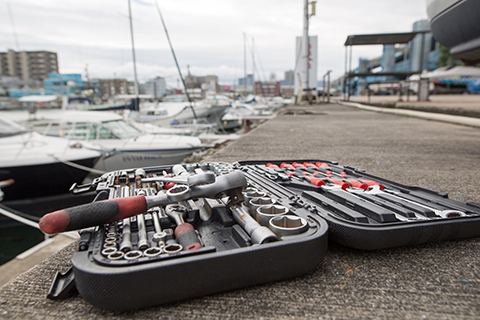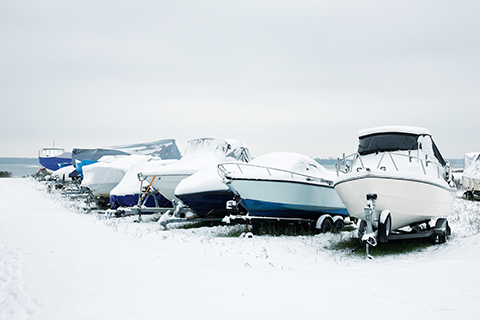Get ready for the summer with NGK SPARK PLUG’s latest marine range update

Easy motoring
Just like any other vehicle powered by an ignition combustion engine, fully functioning spark plugs are of utmost importance to guarantee a boat’s smooth sailing. Afterall, a faulty spark plug can cause a variety of performance-related issues, meaning that a boat trip which may originally have promised so much, can end up being over all too soon. Common issues pertaining to a faulty spark plug may include:
- Difficulty in starting the boat’s engine
- A loss of engine power
- Sudden cutting out of the engine
- Decreased acceleration
If one or more of these symptoms occurs, the removing and inspecting of the boat’s spark plugs is highly recommended. Things to look out for upon examining a plug include rust or droplets of water which could be caused by the entrance of water into the cylinder or its presence in the fuel.

Excessive wear of the electrodes, however, is a key indication that the spark plug’s lifespan has run its course and is due a replacement. Replacement intervals depend on the frequency of use and the type of metal used in the plug. Check the owner’s manual for further information.
Another thing to look out for is carbon fouling, which occurs when a spark plug is unable to reach the required temperature of 450°C – when it begins to self-clean by burning off carbon deposits. When a spark plug is fouled, the insulator nose at the firing tip is coated with a foreign substance such as fuel, oil, or carbon. This can result in the engine misfiring or failing to start. Common reasons for this include the wrong spark plug heat range, a non-optimal engine combustion process and poor running conditions.
Optimum ignition performance
Since May 2021, NGK SPARK PLUG’s already impressive marine Aftermarket coverage has been further bolstered by the launch of the Yellow Box Line reference MR6K-9 as well as the Laser Iridium OE-quality reference, ILMAR7E9. The former is an addition to the company’s standard range, designed particularly for the Suzuki DF9.9B engine, while the latter is a first-to-market spark plug fitting the Yamaha V8 F425 engine. “The release of both of these new spark plugs provide a further expansion of our already comprehensive marine range of engine powered water vessels,” says Tufan Baysal, Director Aftermarket, Middle East, Africa, Eurasia at NGK SPARK PLUG.
Featuring a centre electrode made from one of the world’s hardest metals, iridium, which has a melting point of 2,450°C and a ground electrode of platinum, NGK SPARK PLUG’s Laser Iridium range provides superior ignitability, a long service life and lower emissions. Iridium electrodes can be as thin as 0.6mm in diameter, meaning that a lower amount of voltage is needed to produce a powerful spark that on average lasts twice as long as standard nickel plugs.
Increasing the performance of high-speed boats which can avail of better ignition, smoother running and improved acceleration, Laser Iridium also benefits slower-moving vehicles such as canal narrowboats. While standard nickel plugs tend to soot up at low speeds, Laser Iridium has a specially designed annular gap that prevents the build-up of soot deposits.

Getting ready for the water
Just like motorcycles, lawnmowers and classic cars, many boats spend the winter in hibernation. Before departing land, it is recommended to perform a thorough inspection, cleaning as well as any necessary maintenance on the boat. Such measures may prevent certain problems developing in later months. The main tasks to carry out include:
- Inspection and cleaning: Depending on the storage circumstances, boats can be subjected to effects of frost, rain, humidity and pests, to name but a few. This means that a full inspection of your boat is necessary to identify any parts requiring repairs or cleaning.
- Test the boat’s electrics: A fully functioning battery is vital to many onboard systems. Using a battery tester, analyse the boat’s deep cycle battery. Ensure that every electrical outlet is working. Check the boat’s lamps and light bulbs too.
- Engine and fluids check: Motoring in water, especially if it contains salt, can have a corrosive effect on the engine. Fluids such as oil and coolant which should have been drained at the end of the sailing season, must be refilled and the oil filter should be replaced. In contrast, the fuel tank should have been fully filled during this period. This action prevents condensation from forming. Over the course of the winter, however, this fuel may go stale, so it may need to be drained and replaced.
- Safety procedures: A boat should be equipped with lifejackets, flares, fire extinguishers, radios, navigation tools and first aid kits. Finally, all of the boat’s paperwork such as ownership documents, operating manuals and emergency information must be onboard, while the boat’s insurance has to be up-to-date.
NGK SPARK PLUG wishes all marine enthusiasts a fun and safe time out on the water in 2021!
